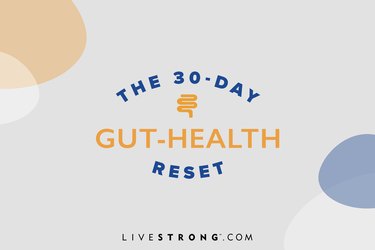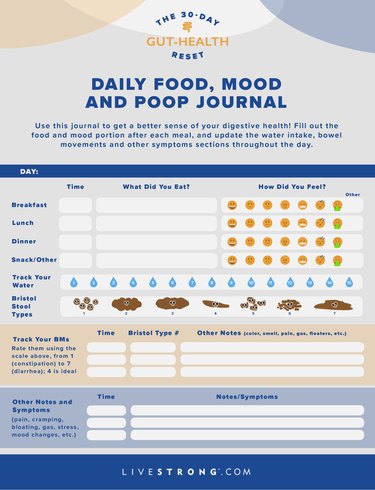
Time for a gut check. No, really: How's your digestive system doing?
If you've been feeling bloated, gassy and/or sluggish, your gut could be trying to tell you something's up. And when your gastrointestinal (GI) tract isn't working like it should be, your overall health struggles, too.
That's why the LIVESTRONG.com team has partnered with Vincent Pedre, MD, author of Happy Gut and creator of the 28-Day Happy Gut Cleanse and the Happy Gut app, for The 30-Day Gut-Health Reset.
The goal of this plan is to get you on the path to optimal gut health — even if you don't have any GI distress. It's also an opportunity to reduce or eliminate any uncomfortable symptoms if you are experiencing them.
Keep in mind this challenge is not a replacement for medical care. Always speak with a health care professional about serious symptoms, such as blood when you have a bowel movement, severe abdominal pain, heartburn not relieved by antacids or ongoing vomiting or diarrhea, according to the U.S. National Library of Medicine.
Your Weekly Gut-Health Reset Themes
- Week 1: Take Stock: Start a gut-health tracker to get a better sense of how your digestive system is doing.
- Week 2: Cut It Out: Eliminate certain foods and activities that can disrupt normal GI function.
- Week 3: Add It In: Ensure you're eating the right foods — such as fiber, probiotics and prebiotics — for optimal gut health.
- Week 4: Slow It Down: Learn how to eat mindfully and soothe stressors to improve your digestion.
- Week 5: Fine-Tune It: Make a few additional gut-friendly lifestyle tweaks and use your tracker to spot digestion-related trends.
Why Gut Health = Good Health
Your digestive system is a complicated operation.
With help from the pancreas, liver and gallbladder, the GI tract — a series of linked organs that include the mouth, esophagus, stomach and small and large intestines — works to break down the food you eat, extract key nutrients that go to the rest of your body to use as fuel and then eliminate the remaining waste products the body doesn't need, according to the National Institute of Diabetes and Digestive and Kidney Diseases.
But there's more to gut health than digestion. "The gut is a foundation of health," Dr. Pedre says. If you want to optimize your overall health, you have to optimize your gut health, he says. "That foundation is critical to the rest of the body."
For starters, digestive health is essential for your body's immune response, he says. In fact, a large portion of your immune system is in your GI tract, according to Johns Hopkins Medicine. The lining of your gut acts as a physical and chemical barrier, producing antimicrobial substances that neutralize and prevent harmful pathogens from getting to the rest of your body, as noted in a 2017 review in Experimental and Molecular Medicine.
Plus, your gut and brain communicate with each other constantly, thanks to what's called the gut-brain axis or the gut-brain connection. Through chemicals like hormones and neurotransmitters, the brain can modify bacterial behavior in the gut, and vice versa — bacteria, viruses and fungi in the gut can affect chemicals in the brain, according to the Cleveland Clinic.
In a February 2019 study in Nature Microbiology, researchers found that people with depression were more likely to have lower "overall bacterial abundance" in their guts, while people who self-reported having a high quality of life were more likely to have two specific types of bacterial species in their guts. That said, more research — especially in humans — is needed to better understand the gut-brain connection.
How to Join the 30-Day Gut-Health Reset
- Step 1: Start your gut-health tracker. Print our template (see the example below) to log everything you eat and drink (our MyPlate app can help with this part, too!), how you feel after eating, your water intake and bowel movements throughout the day. Each page has space for two days. Print as many copies as you’ll need.
- Step 2: Join our Challenge Facebook Group. This supportive community is where you'll find tips, motivation and expert advice throughout the month.
- Step 3: Reset your gut health! Follow along with the weekly tasks and track your food and GI symptoms to gain insight into your gut function and make lasting changes for improved digestive health.
Ready to Get Started?
Read on for more details about and links to each week of the challenge.
Take Stock
Your goals for Week 1 are:
- Start your gut-health tracker
- Download LIVESTRONG.com's MyPlate app
- Calculate your recommended fiber and water intake
You can't fix anything — your gut included — until you figure out what's going on. That's why the first week of this reset is devoted to getting a clear picture of what's happening with your insides. One of the best ways to do that is with a gut-health tracker.
Starting from Day 1 and continuing throughout the entire month, you'll log what you eat and drink, as well as how you feel after eating. You'll also track your bowel movements because (no major surprise here) they can be very telling of your gut health.
This week, you'll also check your fiber and water intake. Both play important roles in healthy gut function. Most people should aim for 21 to 38 grams of fiber daily, per the U.S. National Library of Medicine. And, in general, aim for 2.7 liters (about 11 cups) to 3.7 liters (about 15 cups) of water each day, according to the National Academies of Sciences.
Get the full Week 1 plan here.
Cut It Out
Your goals for Week 2 are:
- Cut out (or cut back on) added sugar
- Cut out (or cut back on) highly processed foods
- Cut out (or cut back on) alcohol
- Swap high-intensity workouts for lower-intensity exercises
- Continue using your gut-health tracker
Once you know a bit more about your diet and how it's making you feel, you can start to eliminate foods and activities that are potentially causing GI distress. That means saying buh-bye to added sugars, artificial sweeteners, highly processed foods, alcohol and high-intensity workouts (sorry, HIIT lovers).
"During this time, we want to take away all the things that are going to promote inflammation while we're re-working the internal environment in your body to become more anti-inflammatory," Dr. Pedre says.
Be aware that this is likely the toughest week of the challenge. During this phase, you might feel worse before you start to feel better, as your body adjusts to a healthier diet, Dr. Pedre says.
But stay strong: "After you come out the other side, you're going to feel the best you've felt in a long time," he says.
Get the full Week 2 plan here.
Add It In
Your goals for Week 3 are:
- Add probiotics and prebiotics to your diet
- Up your fiber intake
- Consider your digestive enzyme needs
- Get active with walking and stretching
- Continue using your gut-health tracker
Removing or reducing potential causes of inflammation in your digestive system is a great start, but now it's time to introduce some new things that will help your gut stay healthy and balanced.
That starts with probiotics and prebiotics. Probiotics are good-for-your-gut microscopic organisms that live in your GI tract; in healthy amounts, they help keep symptoms like diarrhea and constipation at bay, Dr. Pedre says. Prebiotics, on the other hand, are non-digestible food ingredients that fuel probiotic growth. "With the prebiotics, you're promoting the good bacteria," he says.
This week, you'll discover which foods contain probiotics and prebiotics and how to combine them to keep your gut balanced, as well as a variety of fiber-rich, digestion-supporting foods to include in your diet and the best workouts to keep things moving.
Get the full Week 3 plan here.
Slow It Down
Your goals for Week 4 are:
- Practice mindful eating
- Prioritize stress relief
- Add yoga to your routine
- Continue using your gut-health tracker
In a world that makes multitasking feel mandatory, it's important to slow things down now and then, especially when it comes to eating and exercise. Constantly snacking on the move or making all your sweat sessions super high-intensity can leave you stressed out and lethargic.
"When you eat at your desk in five minutes, you're in a stressed-out state. You can't digest well in that state," Dr. Pedre says. That's where mindful eating practices — think: chewing your food thoroughly and pausing between bites — can help.
"You need to rest to digest," he says. "In other words, you need to give your gut space by slowing down in order to digest better."
And because you likely already want to limit stress, you'll want to make sure your gut health is in order, as there's a strong connection between the two.
"We're wired to shut down the gut in a stressed state," Dr. Pedre says. If you're under constant pressure, it's quite likely your gut won't function properly, he explains, potentially leading to an upset stomach or intestinal discomfort.
This week, try doing yoga, meditating, connecting with friends or keeping a gratitude journal to help circumvent that stress and its negative effects on digestion.
Get the full Week 4 plan here.
Fine-Tune It
Your goals for Week 5 are:
- Drink more water
- Get at least 7 hours of sleep each night
- Read through your gut-health tracker to identify potential patterns and signs of food intolerances to discuss with your doctor
The first four weeks of this plan focus on the changes that will have the biggest effect on your gut health. But Week 5 is about making a few minor adjustments to your daily routine that, when combined, add up to better GI function.
"Water is really important for the movement of substances through the body [especially in your gut], which is why it's critical to get the right amount," Dr. Pedre says.
The quality and quantity of your sleep can affect your gut health, too. Sleeping longer — and sleeping well — was correlated with a more diverse gut microbiome, per a small October 2017 PLOS One study in men, and getting too little sleep can send you searching for high-carb, high-fat pick-me-ups that won't do your gut any favors, Dr. Pedre says. Aim for seven to nine hours a night, going to bed and waking up at relatively the same times.
Lastly, this is the week to check back in with your tracker and see if you notice any particular foods or drinks that have been causing a pattern of GI symptoms. Then, chat with your doctor about any trends to see if you'd benefit from tests or treatment.
Get the full Week 5 plan here.
Is this an emergency? If you are experiencing serious medical symptoms, please see the National Library of Medicine’s list of signs you need emergency medical attention or call 911.





